In the rapidly evolving education landscape, virtual classrooms have emerged as a pivotal component, revolutionizing how education is delivered and consumed. The transition from traditional classrooms to virtual platforms necessitates the evaluation of their effectiveness and efficiency, ensuring that they meet educational goals while providing an engaging learning experience. Hence, establishing robust virtual classroom quality metrics becomes indispensable. These metrics serve as essential indicators to assess various aspects of virtual learning, from technological capabilities to pedagogical effectiveness, directly influencing the overall learning experience.
Read Now : Career-focused Vocational Training Program
The Importance of Virtual Classroom Quality Metrics
The development and implementation of virtual classroom quality metrics are crucial for educators, administrators, and policymakers alike. These metrics help in identifying strengths and weaknesses within the virtual learning environment, providing insights necessary for enhancement and optimization. The quality metrics encompass various dimensions, including technological infrastructure, user engagement, content delivery, and learning outcomes. Technological infrastructure evaluates the reliability and accessibility of virtual platforms, ensuring seamless connectivity and interaction among stakeholders. Meanwhile, user engagement metrics assess the interaction levels of students and teachers, the effectiveness of communication tools, and the extent of student participation in virtual activities.
Content delivery metrics focus on the quality, relevance, and comprehensiveness of educational materials provided to students. Furthermore, learning outcomes emphasize the effectiveness of virtual instruction in achieving educational objectives, reflected in students’ performance and progression. Collectively, these virtual classroom quality metrics guide the continuous improvement of virtual education, fostering an environment where learners can thrive. By leveraging these metrics, educational institutions can ensure their virtual classrooms are conducive to learning, adaptable to different needs, and responsive to evolving educational demands.
Key Components of Virtual Classroom Quality Metrics
1. Technological Infrastructure: Evaluating the digital tools that facilitate the learning platform’s operations, focusing on system reliability, accessibility, and scalability is crucial.
2. User Engagement: Measuring student interaction and participation levels, ensuring active involvement and productive communication in virtual learning scenarios.
3. Content Delivery: Assessing whether educational materials are delivered effectively, meeting educational standards and fostering student understanding.
4. Learning Outcomes: Analyzing student achievements and progress, indicative of the effectiveness of virtual instruction in meeting educational goals.
5. Feedback Mechanisms: Incorporating tools for receiving and processing feedback from users to continuously enhance the virtual learning environment.
Enhancing Digital Learning through Quality Metrics
In striving for exemplary digital learning environments, the utilization of virtual classroom quality metrics provides a systematic approach to determine the efficiency and effect of digital education. These metrics empower education providers by delivering insights on areas needing refinement, encouraging iterative improvements. This continuous enhancement cements virtual classrooms’ relevance and efficacy, ensuring alignment with educational standards and learner expectations. Adopting a comprehensive strategy to integrate these metrics can significantly impact learning experiences, optimizing both pedagogy and technology use.
Read Now : Accredited Online Bachelor Degrees
The proactive analysis of virtual classroom quality metrics also plays a pivotal role in customizing educational experiences to cater to diverse learner needs. By examining diverse metrics, educators gain a deeper understanding of individual and group learning patterns, allowing for personalized and adaptive learning approaches. This level of customization is vital in maintaining engagement and motivation among students, especially in virtual settings where physical cues are absent. Consequently, a data-driven approach using accurate and relevant metrics not only supports an institution’s educational mandate but also fortifies its commitment to providing a robust, inclusive, and forward-thinking educational environment.
Challenges in Virtual Classroom Quality Metrics Implementation
Implementing virtual classroom quality metrics is not without its challenges. The complexity of digital ecosystems often necessitates sophisticated tools and methodologies to accurately capture and interpret relevant data. Furthermore, ensuring the privacy and security of data collected remains a primary concern, requiring stringent measures to safeguard sensitive information. Balancing the need for detailed data with ethical considerations is paramount in the deployment of these metrics.
Additionally, resistance to change presents another hurdle, as stakeholders accustomed to traditional methods may exhibit reluctance towards adopting new evaluation strategies. Thus, fostering an organizational culture that values continuous improvement and data-driven decision-making is essential. Training and support for educators and technical staff can facilitate smoother transitions, promoting a broader understanding of the value derived from effective metric implementation.
Case Studies of Successful Quality Metrics Integration
The adoption of effective virtual classroom quality metrics can take inspiration from institutions that have successfully implemented these systems. For instance, universities that have adopted comprehensive metric frameworks often report enhanced academic performance and student satisfaction. They utilize integrated systems combining student feedback, performance data, and technological evaluations to offer improved learning experiences. Moreover, these institutions frequently engage in collaborations for sharing best practices and innovations in digital learning, showcasing a commitment to advancing virtual education.
In implementing these metrics, institutions also realize improvements in operational efficiencies, reflecting their ability to allocate resources more effectively based on data insights. Therefore, learning from these successful models can help other educational bodies navigate the complexities of modern digital education and leverage metrics effectively for sustained growth.
Conclusion on Virtual Classroom Quality Metrics
In summary, virtual classroom quality metrics serve as invaluable tools in the quest to deliver superior digital learning experiences. Their comprehensive nature addresses multifaceted aspects of the virtual classroom environment, facilitating informed decision-making and continuous enhancement. As education stakeholders strive to meet the evolving demands of education, these metrics ensure that virtual classrooms remain relevant, effective, and responsive to change. They represent a strategic asset contributing to the adaptability and success of educational institutions navigating the complexities of digital transformation in education.
